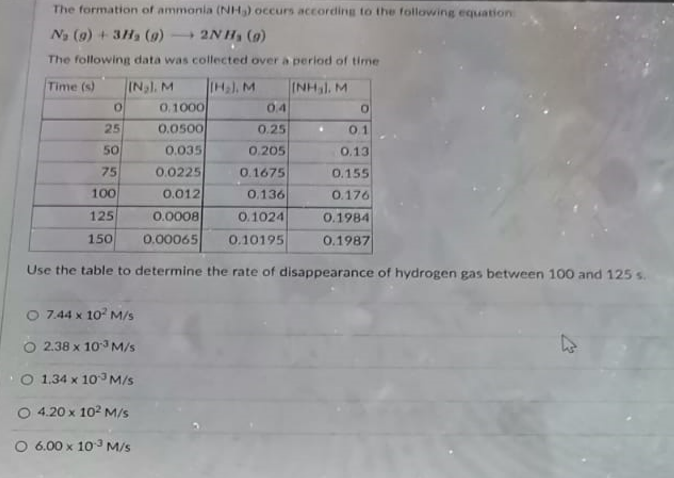The formation of ammonia (NH) occurs according to the following equation N3 (9) + 3H2 (9) 2NH, (9) The following data was collected over a period of time Time (s) INl. M IHa), M INHl, M 0.1000 0.4 25 0.0500 0.25 0.1 0.035 0.0225 50 0.205 0.13 75 0.1675 0.155 100 0.012 0.136 0.176 0.0008 0.1024 0.10195 125 0.1984 150 0.00065 0.1987 Use the table to determine the rate of disappearance of hydrogen gas between 100 and 125 s. O 7.44 x 10- M/s O 2.38 x 10 M/s O 1.34 x 10° M/s O 4.20 x 102 M/s O 6.00 x 10 M/s
The formation of ammonia (NH) occurs according to the following equation N3 (9) + 3H2 (9) 2NH, (9) The following data was collected over a period of time Time (s) INl. M IHa), M INHl, M 0.1000 0.4 25 0.0500 0.25 0.1 0.035 0.0225 50 0.205 0.13 75 0.1675 0.155 100 0.012 0.136 0.176 0.0008 0.1024 0.10195 125 0.1984 150 0.00065 0.1987 Use the table to determine the rate of disappearance of hydrogen gas between 100 and 125 s. O 7.44 x 10- M/s O 2.38 x 10 M/s O 1.34 x 10° M/s O 4.20 x 102 M/s O 6.00 x 10 M/s
Chemistry for Engineering Students
4th Edition
ISBN:9781337398909
Author:Lawrence S. Brown, Tom Holme
Publisher:Lawrence S. Brown, Tom Holme
Chapter11: Chemical Kinetics
Section: Chapter Questions
Problem 11.35PAE: 11.35 For the reaction 2 NO(g) + 2 H?(g) — N,(g) + 2 H,O(g) at 1100°C, the following data have been...
Related questions
Question

Transcribed Image Text:The formation of ammonia (NH) occurs according to the following equation
N (9) + 3H (9)
- 2N H, (a)
The following data was collected over a period of time
IHa), M
INHl. M
0.4
Time (s)
INl. M
0.1000
0.0500
0.035
25
0.25
0.1
50
0,205
О.13
0.1675
0.0225
0.012
75
0.155
100
0,136
0.176
125
0.0008
0.1024
0.1984
150
0.00065
0.10195
0.1987
Use the table to determine the rate of disappearance of hydrogen gas between 100 and 125 s.
7.44 x 10 M/s
O 2.38 x 10 M/s
о 1.34 х 10Эм/s
O 4.20 x 102 M/S
O 6.00 x 103 M/s
Expert Solution
This question has been solved!
Explore an expertly crafted, step-by-step solution for a thorough understanding of key concepts.
Step by step
Solved in 2 steps with 1 images

Knowledge Booster
Learn more about
Need a deep-dive on the concept behind this application? Look no further. Learn more about this topic, chemistry and related others by exploring similar questions and additional content below.Recommended textbooks for you

Chemistry for Engineering Students
Chemistry
ISBN:
9781337398909
Author:
Lawrence S. Brown, Tom Holme
Publisher:
Cengage Learning

Chemistry: An Atoms First Approach
Chemistry
ISBN:
9781305079243
Author:
Steven S. Zumdahl, Susan A. Zumdahl
Publisher:
Cengage Learning

Chemistry & Chemical Reactivity
Chemistry
ISBN:
9781133949640
Author:
John C. Kotz, Paul M. Treichel, John Townsend, David Treichel
Publisher:
Cengage Learning

Chemistry for Engineering Students
Chemistry
ISBN:
9781337398909
Author:
Lawrence S. Brown, Tom Holme
Publisher:
Cengage Learning

Chemistry: An Atoms First Approach
Chemistry
ISBN:
9781305079243
Author:
Steven S. Zumdahl, Susan A. Zumdahl
Publisher:
Cengage Learning

Chemistry & Chemical Reactivity
Chemistry
ISBN:
9781133949640
Author:
John C. Kotz, Paul M. Treichel, John Townsend, David Treichel
Publisher:
Cengage Learning

Chemistry & Chemical Reactivity
Chemistry
ISBN:
9781337399074
Author:
John C. Kotz, Paul M. Treichel, John Townsend, David Treichel
Publisher:
Cengage Learning

Principles of Modern Chemistry
Chemistry
ISBN:
9781305079113
Author:
David W. Oxtoby, H. Pat Gillis, Laurie J. Butler
Publisher:
Cengage Learning

Chemistry: Principles and Reactions
Chemistry
ISBN:
9781305079373
Author:
William L. Masterton, Cecile N. Hurley
Publisher:
Cengage Learning